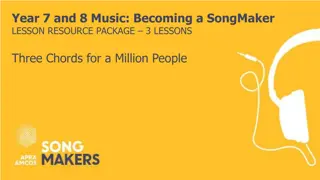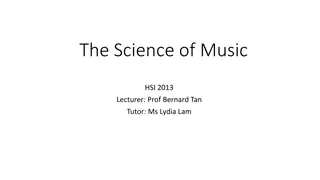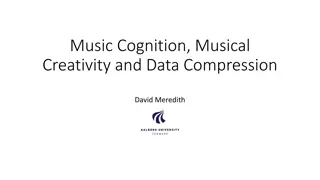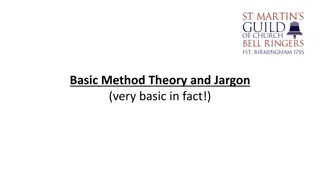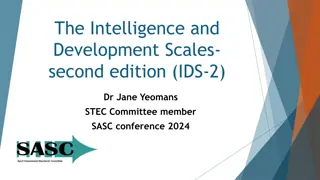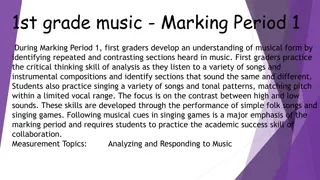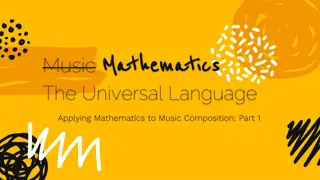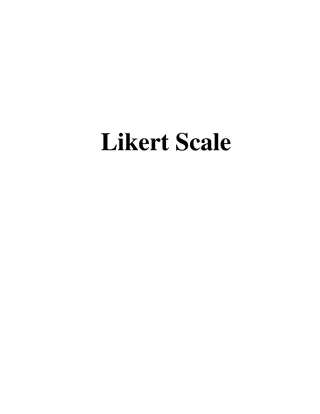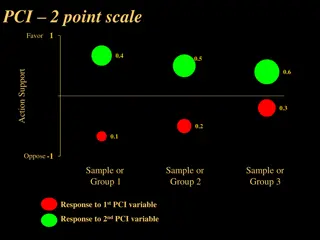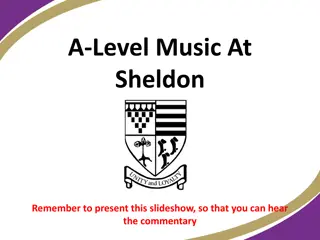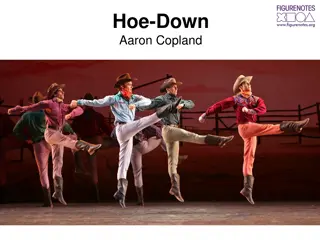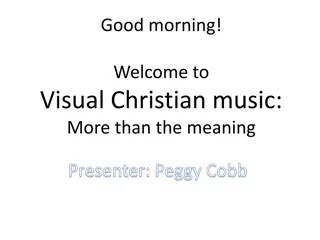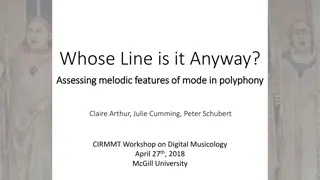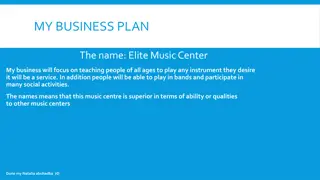Exploring Melodic Ideas with Pentatonic Scales in Music Composition
Delve into the world of music composition by understanding and utilizing pentatonic scales to develop captivating melodies. Learn key terminology, explore the C pentatonic scale, and discover how major and minor pentatonic scales can influence the mood of your compositions. Dive deep into the power and versatility of pentatonics in creating memorable songs and melodic ideas.
Download Presentation

Please find below an Image/Link to download the presentation.
The content on the website is provided AS IS for your information and personal use only. It may not be sold, licensed, or shared on other websites without obtaining consent from the author. Download presentation by click this link. If you encounter any issues during the download, it is possible that the publisher has removed the file from their server.
E N D
Presentation Transcript
Year 7 and 8 Music: Becoming a SongMaker LESSON RESOURCE PACKAGE 2 LESSONS Got a Hook?
Lesson One Pentatonics
Learning Intention: To define key terminology associated with the development of melodic ideas. To identify and explore the C pentatonic scale as a basis for developing melodic ideas. Success Criteria: I can define and explain key terminology associated with the development of melodic ideas in my song concept. I can demonstrate my practical understanding of the use of the pentatonic scale in the development of melodic ideas over the chord progression and groove in my song concepts.
Writing a melody Here s Triple J s Linda Marigliano and Dan Goldings working with producer Simon Cohen to develop a melody as they continue writing a song. CLASS DISCUSSION How can a good melody create a memorable song? *watch to 13:00 triple j. (2018, August 28). How do you write a hit song? | What is Music. YouTube. Retrieved January 7, 2023, from https://www.youtube.com/watch?v=iIBMi8LrkOM
Words of the Day Melody - is a succession of pitches in rhythm. The melody is usually the most memorable aspect of a song, the one the listener remembers and is able to perform. Pentatonic Scale - also called five-note scale or five-tone scale, musical scale containing five different tones.
The Pentatonic Scale The best way to start developing a melody is to start with a simple 5 note scale called the pentatonic scale. There are major and minor pentatonic scales that we can experiment with when improvising a melodic idea over our chord progression. Here is the C Major pentatonic scale: Here is the C minor pentatonic scale:
The Power of Pentatonics Here s David Bennett, discussing the pentatonic scale and sharing some examples of melodies that are build from major and minor pentatonic scales. *watch to 3:00 CLASS DISCUSSION Do major or minor pentatonic scales create different moods? David Bennett Piano. (2020, September 21). Songs that use the Pentatonic scales. YouTube. Retrieved January 7, 2023, from https://www.youtube.com/watch?v=MGpUscFY9RA
Why Pentatonics? Here s David Bennett again, discussing the versatility of the pentatonic scale and how it can work over our chord progression in the key of C. *watch to 5:46 CLASS DISCUSSION Besides vocal melodies, the pentatonic scale can also be useful in creating other melodic ideas in a song. What other instruments can you hear featuring the pentatonic scale? David Bennett Piano. (2020, September 21). Songs that use the Pentatonic scales. YouTube. Retrieved January 7, 2023, from https://www.youtube.com/watch?v=MGpUscFY9RA
Experiment and Practice - Piano For the remainder of this lesson you can choose to return to the guitar or the piano to learn and experiment with C Major and C minor pentatonic scales over the chord progression on your DAW. ON PIANO
Experiment and Practice - Guitar For the remainder of this lesson you can choose to return to the guitar or the piano to learn and experiment with C Major and C minor pentatonic scales over the chord progression on your DAW. ON GUITAR C Major Pentatonic C minor Pentatonic
Enter the Playground Without an instrument, you can experiment with pentatonic scales by returning to Ableton s learning music platform The Playground here: https://learningmusic.ableton.com/ the-playground.html ACTIVITY Try experimenting with pentatonic combinations over a chord progression and groove (from earlier).
Lesson Two Melodies, riffs and hooks
Learning Intention: To identify and analyse riffs and hooks in popular song. To demonstrate practical application of a riff or hook in the development of a song section on the piano or guitar. Success Criteria: I can identify and explain the role of a riff and a hook in popular song. I can demonstrate my practical understanding of the development of riffs and hooks by experimenting with ideas on the piano or guitar within my song concept.
Words of the Day Hook - a musical idea, often a short riff, passage, or phrase, that is used in popular music to make a song appealing and to "catch the ear of the listener . Riff - a short, melodic and rhythmic idea of a few bars and it is prominent enough to influence the structure and character of a song. Improvisation is the creative activity of immediate ("in the moment") musical composition.
What is an Earworm? In this video from Linda Marigliano discusses what an earworm is how we can work with neuroscience to create memorable hooks and riffs. CLASS DISCUSSION What musical elements combine to create a song that is more likely to stick in your head? ABC News In-depth. (2018, November 9). Why is that song stuck in my head? (Earworms) | What Is Music. YouTube. Retrieved January 7, 2023, from https://www.youtube.com/watch?v=l8BpPx_8Vpg
What is a Hook? In this video from LANDR, Isabelle discusses what a hook is and how to write and develop a hook for your song. CLASS DISCUSSION What makes a good hook? How can you create a hook? What are the elements of a good hook? *watch to 4:00 LANDR. (2020, June 19). How To Write A Hook: Catchy Melodies Explained. YouTube. Retrieved January 7, 2023, from https://www.youtube.com/watch?v=pF2Saxg6LQc
Create a Hook or Riff For the remainder of this lesson you can choose to return to the guitar or the piano to learn and continue to experiment with the C Major and C minor pentatonic scales over the chord progression to create a hook on your DAW. Here are some tips to keep in mind when working through a hook or riff: Keep it simple and uncomplicated (1 3 notes). Repeat ideas to help make it memorable. Experiment with sounds and timbres can it be a sound on distorted guitar (like a riff) or can it be synthesised on piano or even whistled? A mix of longer and shorter rhythmic values and close intervals (no big jumps and leaps between notes).
Enter the Playground Without an instrument, you can experiment with pentatonic scales to create a hook by returning to Ableton s learning music platform The Playground here: https://learningmusic.ableton.com/ the-playground.html ACTIVITY Try experimenting with pentatonic combinations over a chord progression and groove (from earlier).



